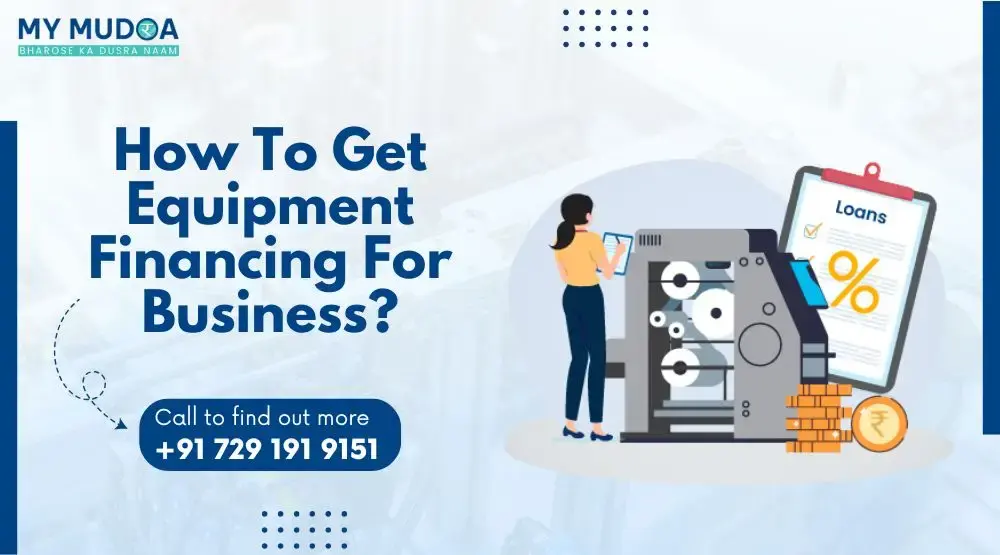
"Looking for equipment finance? Apply for Equipment Loans online and grow your business hassle-free."

Published: 24 April 2025
Updated: 24 April 2025
Need new equipment or tools, but concerned about the expense? Whether it is a coffee machine for your workplace or a ₹50 lakh excavator for your building site — don't let cash crunch get in the way.
Equipment finance can assist you in acquiring the tools you require without impacting your business cash flow. Rather than paying the entire amount in advance, you repay in convenient installments.
This guide will assist you in knowing:
Equipment financing refers to obtaining a loan or lease to purchase business equipment such as machines, tools, or autos. The best news? The equipment itself is used as collateral, so the lender considers it less risky than unsecured loans. In simple words, It refers to borrowing cash to purchase or lease equipment, vehicles, or machinery for your business. The equipment itself is utilized as collateral, so you can qualify more easily—even if you don't possess other collateral.
You are likely to come across the following financing options when you head out to buy equipment for your business:
Borrow a lump sum to buy equipment. Repay via EMIs over 1-10 years. You own the asset after repayment.
Rent equipment for a fixed period (e.g., 3-5 years). Lower upfront costs, but you don’t own the asset.
Use the equipment for a specified time with the choice of owning it at lease expiration.
Example: A construction firm takes a construction equipment loan, like Central Bank of India’s CCEF, to purchase a ₹50 lakh excavator, which is repaid in 5 years. The excavator is used as collateral, and the company retains it after the repayment of the loan.
Lenders evaluate several factors before approving equipment finance for business:
|
Criteria |
Requirement |
|
Business Vintage |
2-3+ years (startups may need co-applicants) |
|
Credit Score |
650+ (700+ for better rates) |
|
Annual Revenue |
₹10 lakh-₹5 crore+ (varies by lender) |
|
Down Payment |
10%-25% of the equipment cost |
|
Documentation |
ITRs, bank statements, equipment quote, and GST |
|
Business Type |
MSMEs, proprietorships, partnerships, LLPs, companies, contractors, etc. |
Some lenders, like Axis Bank, offer collateral-free loans up to ₹3.5 crore for eligible MSMEs, while others may require additional security for higher amounts.
There are many banks and NBFCs that provide easy equipment loans for businessmen. Here are a few of them:
|
Name of Bank / NBFC |
Amount |
Interest Rate |
Processing Charges |
|
Tata Capital |
Rs.0.40 Lakh - Rs.75 Lakh |
15% onwards |
2.50% |
|
HDFC Bank |
As per requirement |
7.50% - 14.93% p.a. |
1-1.5% |
|
Axis Bank |
As per requirement |
9% - 14.50% p.a. |
0.30% or Rs.10,000/- whichever is less |
|
Bajaj Finserv |
Up to Rs.50 Lakh |
14% - 30% p.a. |
3.54% |
|
Poonawalla Fincorp |
Up to ₹10 Crore |
9.99% onwards |
2% |
|
Kotak Mahindra Bank |
As per the requirement |
Up to 24% |
Up to 3% |
Note: Please note that the rates are subject to change periodically.
To apply for an equipment loan, you’ll generally need:
The process to apply for an equipment loan is simple. Here are the key steps involved:
Identify the equipment type, cost, and urgency. For example, a bakery may need a ₹15 lakh oven, while a logistics firm might require a ₹1 crore truck fleet.
Use platforms like My Mudra to compare:
Top Lenders: SBI, HDFC Bank, Bajaj Finance, Tata Capital, Axis Bank, Central Bank of India.
Most lenders require:
The lender reviews your application, verifies documents, and may conduct a site visit. If approved, funds are disbursed directly to the equipment vendor or to your business account for payment.
Since 2013, My Mudra has helped 10,000+ businesses secure ₹10,000Cr+ in funding. Here’s why we’re trusted:
Business equipment financing is a smart strategy to acquire assets, advance technology, and remain competitive without tapping into your cash flow. Through comparing lenders, enhancing your credit rating, and taking advantage of platforms such as My Mudra, you can gain access to funds to drive business growth inexpensively and efficiently.
Ready to upgrade your equipment? Apply for an equipment loan today!
Ans: Startups can qualify by providing a strong business plan, co-applicant, or higher down payment. Some government schemes also support new businesses.
Ans: A construction machinery loan is a tailor-made facility to purchase machinery such as excavators, cranes, or mixers for concrete for use in building work. The machinery acts as collateral.
Ans: Yes! You can claim depreciation (up to 40%) and interest expenses under Section 32 of the Income Tax Act.
Ans: The lender may repossess the equipment to recover losses, as the asset is hypothecated.
Ans: Yes, many lenders offer collateral-free loans up to a certain limit, with the equipment itself acting as security.
💬 Comments
Leave a comment or ask a question!
Please Enter Your Name
Please Enter Your Email
Please Enter Your Phone
Please Write Your Comment